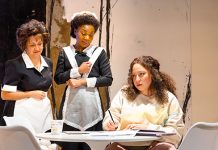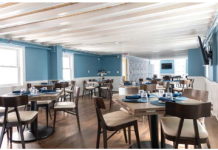LITTLE SILVER – While the preparation for and taking of the college entrance tests are a major source of angst for college-bound high school students, nothing says crunch time like the fall of the senior year when all those college applications are due.
Educators at Red Bank Regional High School (RBR) have sought to ease that stress by providing a multi-session, special college application workshop to its students this summer. In all, more than 50 students took part in the program.
“Senior year is often one of significant anxiety for students. It is the objective of this program to significantly reduce that anxiety with a hands-on workshop for not only the search but also the application completion,” RBR guidance director Dawn Kaszuba said.
Addressing each student at their computer station during the first session, RBR guidance counselor Jill Maline told students, “By the end of your last session, you should be able just go home and submit your applications electronically.”
Step by step, she guided the students through the tools offered through the Naviance online program, which the school district invested in several years ago to better serve students’ college and career search.
From the day they enter high school, all students are given an account which tracks their academic record and helps them discover possible career paths. The program identifies the array of colleges with programs of study in those particular careers.
The students were able to search for colleges by personal preferences from more than 4,500 colleges in the database. Students can narrow their choices by location, size, environment and social environment.
Maline encouraged students visit school campuses this summer to get a better feeling for their preferences – whether small or large, public versus private, city versus urban.
Once students decide on schools they want to consider, a scattergram details how many RBR students in recent history were accepted or rejected with each (anonymous) students’ GPA and SAT/ACT scores.
The student’s own profile also is indicated within the scattergram to determine if the school is a “reach” (a challenge for the student to be accepted), “target” (likely to be accepted) or “safety school” (most likely to be accepted).
Maline recommended students identify five to 10 schools which to apply with one or two in the “reach” range, one or two as “safety” and three to six as “target.”
Naviance also indicates which colleges take the popular, time-saving Common App for its essay requirement. Maline believes that most colleges will eventually adopt the common app since its questions are usually similar to what all colleges require in their essay topics.
During the first session, the actual 2015 College App choice of essay topics was distributed to the students. They were then asked to create an outline on one of the essay topics in time for their next session. Next, they worked with RBR AP English teacher Andrew Forrest for one-on-one conferences on essay drafts, personal statements and the writing process.
The third session is devoted to improving the final essay and answers to other required questions. The fourth session wraps up the process by addressing lingering questions and requesting teacher recommendations through the Naviance system.
Unlike just a few years ago, the college application process is now totally digital. Students are responsible for sending their applications electronically, either through the colleges’ websites or commonapp.org along with their application fee. Guidance counselors send all supporting materials, including transcripts and teacher recommendations, through the Naviance system.
During the first session, Anna Balto and Ceara Gagliano, both of Little Silver, conferred on how to best answer the self-assessment questions.
“I thought I could get a lot out of this with teachers here to guide me,” Balto said about the workshop.
Ceara agreed. “I think this is really helpful and it takes the stress out of doing it during the school year.”
Kristen Jones of Union Beach, who attends RBR’s Pre-Engineering Academy, acknowledged that she was thinking of applying “early action” to Rutgers’ pre-engineering program. “I think this is really helpful to point me in the right direction and I don’t have to balance doing it with school work,” she said.
Matthew Collado of Shrewsbury already picked a favorite school where he is thinking of going for pre-med. He hoped the program would help him understand the college application process so it wasn’t “so scary.”
James Fogerty of Red Bank worked on the college selection page, identifying five schools in which he was very interested. Adrama major in RBR’s Visual & Performing Art Academy, he chose schools with good theater programs so he can minor in the performing arts, while majoring in liberal arts.
“I heard about this college application program from my friends and thought it would be a great help, especially with the college essay, and I also wanted to learn how to better navigate Naviance,” Fogerty said.
Once the college applications are submitted, another college-based activity occurs – figuring out how to pay for higher education and seeking scholarships to defray the cost.
Maline reminded students that Naviance is updated constantly as the scholarship opportunities are made available. She encouraged them to check their account site weekly. At any point, the site could have more than 100 scholarship opportunities, including, in most cases, a download for the scholarship application.
Once the college and scholarship applications are sent, the great waiting game for acceptance begins. A few stressful days occur before the holiday break for those seeking early decision or early action replies. The great majority of regular decisions students will have to bear that anxiety until early April.














